
Perleidus is an extinct genus of ray-finned fish from the Triassic period. Fossils have been found in the Middle Triassic of Italy, Switzerland, and China. The inclusion of Early Triassic species in the genus Perleidus was questioned.
The Xiagou Formation is the middle strata of the Xinminbao Group. It is named for its type site in Xiagou, in the Changma Basin of Gansu Province, northwestern China and is considered Early Cretaceous in age. It is known outside the specialized world of Chinese geology as the site of a Lagerstätte in which the fossils were preserved of Gansus yumenensis, the earliest true modern bird.

Pteronisculus is an extinct genus of prehistoric ray-finned fish that lived during the Early Triassic and Middle Triassic epochs of the Triassic period worldwide.
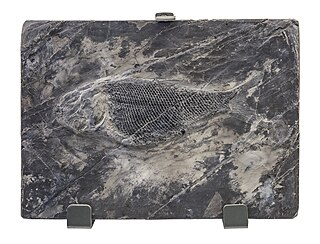
Asialepidotus is an extinct genus of prehistoric marine ray-finned fish that lived during the Ladinian stage of the Middle Triassic epoch. It contains a single species, A. shingyiensis, from Guizhou, China.
Luganoia is an extinct genus of prehistoric bony fish that lived during the Anisian and Ladinian ages of the Middle Triassic epoch. Fossils were recovered from the Besano Formation of Monte San Giorgio and Besano area and from the Zhuganpo Member of Guizhou, South China. It was also reported from the Ladinian of Spain.
Fukangichthys is an extinct genus of prehistoric bony fish that lived during the Rhaetian stage of the Late Triassic epoch.

Allolepidotus is an extinct genus of prehistoric marine neopterygian ray-finned fish from the Middle Triassic epoch of what is now Italy, Spain, and Switzerland. It was formerly referred to the halecomorph order Panxianichthyiformes, but is now thought to be a member of the Ionoscopiformes.
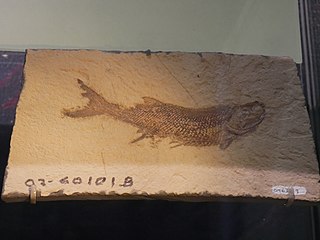
Cyranorhis is an extinct genus of prehistoric bony fish that lived during the Serpukhovian age of the Carboniferous period in what is now Montana, United States.
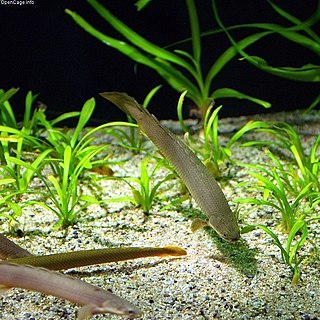
Cladistia is a clade of bony fishes whose only living members are the bichirs of tropical Africa. Their major synapomorphies are a heterocercal tail in which the dorsal fin has independent rays, and a posteriorly elongated parasphenoid.
Neotrirachodon is an extinct genus of therapsids which existed in Russia during the Middle Triassic period. Its type and only species is Neotrirachodon expectatus.
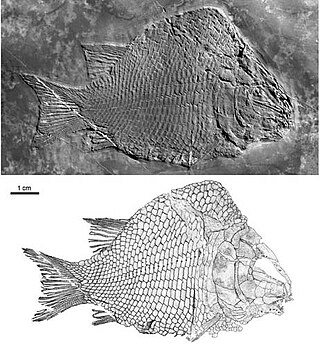
Kyphosichthys is an extinct genus of basal actinopterygian bony fish known from the lower Middle Triassic (Anisian) marine deposits in Luoping, eastern Yunnan Province, southwestern China. The species is the first known fossil record of highly deep-bodied ginglymodians.

Thoracopteridae is an extinct family of prehistoric bony fish; classified with the order Peltopleuriformes. This lineage of Triassic flying fish-like Perleidiformes converted their pectoral and pelvic fins into broad wings very similar to those of their modern counterparts. However, this group is not related to modern flying fish from the family Exocoetidae, instead being a case of convergent evolution.
This list of fossil fishes described in 2014 is a list of new taxa of placoderms, fossil cartilaginous fishes and bony fishess of every kind that have been described during the year 2014, as well as other significant discoveries and events related to paleontology of fishes that occurred in the year 2014. The list only includes taxa at the level of genus or species.
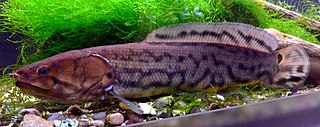
Amia, commonly called bowfin, is a genus of bony fish related to gars in the infraclass Holostei. They are regarded as taxonomic relicts, being the sole surviving species of the order Amiiformes, which dates from the Jurassic to the Eocene, persisting to the present. There are two living species in Amia, Amia calva and Amia ocellicauda, and a number of extinct species which have been described from the fossil record.
The Zhuganpo Formation is a Triassic geologic unit found in southern China. It has historically been known as the Zhuganpo Member of the Falang Formation. A diverse fossil assemblage known as the Xingyi biota or Xingyi Fauna can be found in the upper part of the Zhuganpo Formation. Fossils of the Xingyi biota include articulated skeletons of marine reptiles, abundant fish, and a plentiful assortment of invertebrates indicating a Ladinian to Carnian age for the sediments of the formation.

Ginglymodi is a clade of ray-finned fish containing modern-day gars (Lepisosteidae) & their extinct relatives in the order Lepisosteiformes, the extinct orders Semionotiformes and Kyphosichthyiformes, and various other extinct taxa. Ginglymodi is one of the two major subgroups of the infraclass Holostei, the other one being Halecomorphi, which contains the bowfin and eyespot bowfin and their fossil relatives.

Teffichthys is an extinct genus of ray-finned fish from the Early Triassic epoch. Fossils have been found in Madagascar and China, and possibly also in Angola, Canada, Greenland, and Svalbard.

Redfieldiiformes is an extinct order of ray-finned fish (actinopterygians) which lived from the Middle Triassic to Early Jurassic. Redfieldiiforms were fairly typical Triassic fish in overall anatomy. They had a fusiform body shape with thick, ganoine-covered scales. The dorsal and anal fins were large, positioned opposite from each other, and shifted back, close to the tail. The caudal fin was hemiheterocercal, with the vertebral column and body scales extending into an upper lobe which was equal in size and shape to the lower lobe. They also had several characteristic skeletal traits, such as a hatchet-shaped preopercle, a series of fulcra fringing the fins, a reduced number of branchiostegal rays, and a snout ornamented with tubercles.
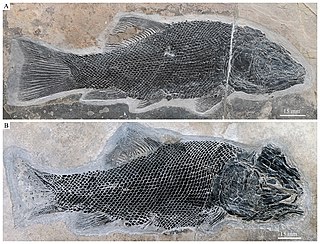
Robustichthys is an extinct genus of ray-finned fish from the Middle Triassic period, contains only one species R. luopingensis. It belonged to the clade Halecomorphi, which were once diverse during the Mesozoic Era, but which are today represented by only a single species, the bowfin. Halecomorphs are holosteans, a clade which first appeared in the fossil record during the Triassic.












